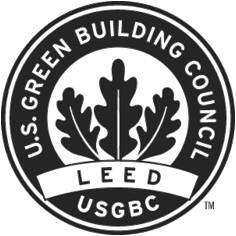
SUBSCRIBE PREVIOUS ISSUES
Spotlight
NIH Green Buildings with Pete Baxter
William “Pete” Baxter is the Head Coordinator for LEED (Leadership in Energy and Environmental Design) projects at the NIH. He has held certification as a LEED AP (Accredited Professional) since 2008, using his expertise to supervise green construction efforts and renovation projects.
“There's no reason for there to be a big cost differential a green design is really just a good design. So if you [put little effort into] a design, that's what you're going to get. If you do a good design, you're going to pay for the good design, but that's what we're after anyway.”
 Pete believes installing green buildings should be a relatively straightforward process. New buildings will already need utility fixtures such as lights and plumbing features, so purchasing sustainable ones during the design phase can save significant time and money. These savings are an added bonus to the resource conservation benefits these features bring about by reducing energy and water use.
Pete believes installing green buildings should be a relatively straightforward process. New buildings will already need utility fixtures such as lights and plumbing features, so purchasing sustainable ones during the design phase can save significant time and money. These savings are an added bonus to the resource conservation benefits these features bring about by reducing energy and water use.
Where the major difficulties arise are in extensive renovations. Given the age of some of the buildings on the NIH Bethesda Campus, even renovating a certain section of the building might not be enough to significantly increase its overall sustainability factor. Alongside this practical challenge, the NIH faces a rather unique reporting challenge.
“The fact that NIH has been proactive in many, many areas [means that] while we've made a lot of gains, some of it we didn't get all of the credit…” He chuckles, “Actually[, we’ve] made some of these areas more difficult for us than they would have been.”
Executive Order 14057 takes a strong approach towards sustainability, mandating large percentages of energy and resource reductions by its deadlines. These percentage reductions are measured from recent baselines, and while this initiative works well for agencies at an average level, NIH has already surpassed certain environmental mandates in the past. Stacking new reduction requirements on top of substantial reductions that have already been previously made, while also maintaining the wherewithal for smooth operations, is proving a very difficult challenge, Pete observes.
“We're in the process now of evaluating our campuses for climate resilience. We're still working on sustainability, making everything more energy and water efficient, using more local materials in our construction projects, reducing greenhouse gases. We're going to get better and better at that.”
As time moves forward and deadlines approach, the NIH continues to work hard towards meeting its sustainability goals. With regards to new buildings, aiming for LEED Gold is the NIH standard, even though Silver is the requirement. With a continuous mindset towards exceeding expectations, Pete believes we should be able to make a positive lasting impact despite our adversities.
He leaves us with these thoughts:
“We are the biggest user of energy and water in HHS. Do we get more scrutiny? Yes, we do. That's just the nature of the thing. But for [HHS] to succeed, we have to succeed. When you're the size of the NIH, that improvement impacts the entire HHS Department.”
For the full transcript, click here.
Featured Article

|
A Look at LEED and the NIH
Green buildings and the implementation of sustainability principles into building design and operation are a crucial aspect of reducing emissions at the NIH. One of the third-party certifications commonly seen for federal buildings is LEED Silver. But what exactly does this mean for green buildings at the NIH?
LEARN MORE
|
Take Action

|
Using Green Building Features
Even with green infrastructure, the core of sustainable buildings lies in the behavior of its occupants! Green building features must be properly utilized to maximize their effect on sustainability. Here are a few simple things you can do to improve your building's sustainability!
LEARN MORE |
NEMS Training
Did you know? The Net-Zero Energy Warehouse sometimes generates more energy than it consumes, thus surpassing even the net-zero energy goal! To learn more about green buildings, please visit the NEMS Training webpage to view a short (20 minute) NIH environmental awareness training video.
The NIH Green Zone Newsletter is a publication intended to inform NIH staff about the Division of Environmental Protection and NIH Green Teams projects and initiatives. The text contained in this newsletter is not copyrighted and can be reprinted without permission. If you use portions of this newsletter in your own publication, we ask that you please credit the source. We welcome your comments and suggestions. Thank you.
|
|---|
|
Division of Environmental Protection | Office of Research Facilities | Office of Management
National Institutes of Health | U.S. Department of Health and Human Services
|